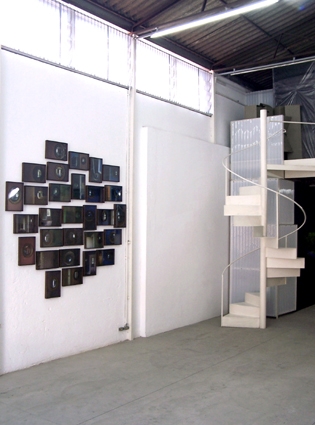In her first solo exhibition at a gallery, Patricia Osses presents works created while living in the home of playwright John Osborne (1929-1994) in England. With literature and local architecture as references, Patricia participated in the program promoted by Artist Links (British Council / Arts Council) in 2008, living between London and Shropshire, the most rural state in the country.
“Houses are books with very thick pages” – this phrase from a previous work served as the theme for Patricia’s project, as the experience of living in a strange place only existed through reading stories and novels by English writers such as Lewis Carrol, Virginia Woolf, the Bronte sisters, and Jane Austen. Within the British Council program, Patricia researched various writers’ houses, choosing to live in The Hurst, a house built in the late 18th century, which had the English playwright John Osborne as its last owner – the author of “Look Back in Anger” (1956), an emblematic work of modern English theater that generated the term “angry young men” to describe himself and other writers of his generation, who used harshness and realism in contrast to previous escapist productions.
Provided by the Arvon Foundation, an institution that offers literary creation residencies to writers, the house was uninhabitable and closed for five years awaiting restoration. To fill its empty rooms while respecting this void, Patricia used immaterial and ephemeral elements in her work, such as sounds, light, the reflection of a mirror, flowers, and plants collected on-site, and a contrast of colors.
John Osborne’s work guided her through the recent past of the house, creating relationships between its architecture, the place’s light, language, culture, the city and countryside, climate, people, movement… inhabiting as a way of deeply relating to the place.
Mirror, the first of the works in this exhibition, invites a journey through the desolate interiors of the house. It’s a photographic essay of 29 images (27 x 40 cm) that capture the internal spaces through the reflection of a round, concave mirror. The mirror was placed on the walls and floors of each room to generate the images. The distortions and imperfections of the 200-year-old surface bring the reflection closer to painting than photography, leading us through interiors with more intense colors, brighter and transparent light, and curved perspectives. Painters Van Eyck, Vermeer, and Velazquez are direct references, as well as Lewis Carroll’s book “Through the Looking-Glass,” found in an old edition in a nearby village. The mirror becomes a gigantic eye hanging on the walls, through which we explore corridors, voids, and corners of each room in the house.
Purple Green is a photographic essay with 07 images (100 x 70 cm) of the performance held outside the house, in the woods and fields around it. The landscape is also part of the house and its windows: according to John Osborne, it was the best view in England. Patricia positions herself and traverses the landscape, enveloped in 50 meters of Indian silk, leaving behind a purple trail from the tail of this endless dress. The precise purple tone creates a curious paradox by configuring the complementary opposite of the green of the English countryside. In the landscape, a masked horse, a lake, a tower, almost unreal monumental trees show their potential for fable when juxtaposed with the feminine figure.
In the mezzanine, John’s House is projected, a 30-minute video formed by successive short films of 1 to 3 minutes, corresponding to each room of the house. In the film, British vocal improviser Phil Minton “sings” as he moves through the house – the proposal made to the singer was to fill the empty interiors with the voice of a single man singing. Phil Minton’s movements were directed and filmed by the artist, as well as his sonic reaction to the different colors, smells, dimensions, echoes, and lights of each room. All the possibilities of a voice (melodies, breaths, words, whispers, roars, murmurs, chords, explosions, and pauses) in a space that had been silent for so long.
At the back of the gallery, a monitor displays Green House, a looping sequence of photographs: a single image that over time only reveals a subtle movement that evolves frame by frame. The house’s greenhouse was practically empty before the installation. It was the first of the works done at the residence, at the beginning of spring. Plants and flowers were collected from the house’s gardens and hung in a way to internally cover the glass wall of the facade. Behind this living curtain that fills all spaces, a body presses against the glass, revealing only an arm, a leg, a neckline, the lace of the dress, exposing itself without ever revealing its identity.
About the artist:
Patricia Osses (Santiago do Chile, 1971) lives and works in São Paulo.
Recent exhibitions: John’s House – a work in progress, Beaconsfield, London (2008); Narratives, Casa da Cultura, Ribeirão Preto (2007); New Directions, Galeria Oeste, São Paulo; Meca – Projects Season, Paço das Artes, São Paulo; Film Trails, SESC Paulista, São Paulo; From body to home, From home to street, SESC Vila Mariana, São Paulo (2006); Occupation, Paço das Artes, São Paulo; 4Hype – Electronic Art and Music, SESC Pompéia, São Paulo; Maria Antonia University Center; Nascente 14 Visuality, São Paulo (2005).
